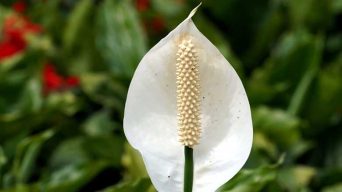Peace lily leaves turn brown due to issues with hydration, often from overwatering or underwatering. Exposure to too much sunlight or low humidity can also cause yellowing and browning. Maintaining proper moisture and providing moderate, indirect sunlight can help keep the leaves healthy.
If you’ve been keeping a Peace lily plant in your home, you may have noticed lately that its leaves have been turning brown.
Houseplants are a great way to add a touch of greenery to your home, but if you have a Peace lily plant in your home, you may have noticed lately that its leaves have been turning brown.
This is a common problem for this type of plant.
Several things can cause leaves to turn brown, but most of them can be fixed with a little bit of care.
Here are some of the most common reasons for Peace lily leaves turning brown and what you can do to fix the problem.
Why Are My Peace Lily Leaves Turning Brown?
The Peace lily (Spathiphyllum) is a type of plant known for its beautiful white flowers. However, peace lilies can also be susceptible to various problems, including brown leaves.
There are several reasons why peace lily leaves may turn brown. The appearance of brown leaves on a peace lily can be attributed to a variety of environmental and cultural conditions, such as excessive direct sunlight, overwatering, or an excess of fertilizer. These factors can cause the plant’s leaves to become yellow, discolored, and dried out.
Here are some of the most common causes and how to address them:
1. Overwatering
Excessive watering can lead to the browning of Peace Lily leaves.
While this may seem like a small problem, it can cause severe damage to the plant.
When overwatering a plant, the roots can become deprived of oxygen, leading to root rot and suffocation, resulting in severe damage to the plant and potentially killing it if not addressed quickly.
This prevents the plant from being able to take up water and nutrients, eventually leading to death.
In addition, overwatered Peace lilies are more susceptible to fungal diseases.
You can tell a Peace lily is overwatered if the leaves are wilting or if the potting mix is soggy.
To prevent your Peace lily from suffering from overwatering, be sure to water it only when the soil is dry.
When you water it, be sure to give it enough so it runs out of the drainage holes.
Peace lilies like to be kept in moist soil but not soggy.
How To Fix It
If your Peace lily has been excessively watered, there are several measures you can take to attempt its rescue.
First, stop watering it and let the soil dry out completely.
Next, remove the Peace lily from its container and check the roots.
If they are black or mushy, the Peace Lily has root rot.
In this case, it is difficult to save the plant.
However, if some of the roots are still white and healthy, you can try to replant the Peace lily in a fresh potting mix.
When planting it in a pot, it is important to have a drainage hole in the bottom so that excess water can escape.
Be sure only to water it when the soil is dry, and don’t overdo it.
2. Too Little Water
The Peace lily is a plant that likes to be kept in moist soil.
If the soil is too dry, the leaves will turn brown.
The plant cannot take up water and nutrients, causing it to suffer.
If the Peace Lily leaves are drooping, it indicates insufficient watering.
The best way to water a Peace lily is until it runs out of the drainage holes.
Peace lilies like to be kept in moist soil but not soggy.
How To Fix It
If your Peace lily is suffering from too little water, there are a few things you can do to help it recover.
First, water the Peace lily until the water runs out of the drainage holes.
Be sure to do this every week or so or when the soil is dry.
Next, you can try misting the Peace lily with water.
Do this once a day, and be sure to keep the leaves dry.
You can also try moving the Peace lily to a location that will get more humidity.
This can be done by placing it on a pebble tray or near a humidifier.
3. Fertilizer Burn
While a fertilizer is essential for promoting plant growth, an excess of it can be harmful. This is particularly true for Peace lilies, which are prone to leaf browning when overfertilized.
The reason behind this lies in the high levels of salts and minerals present in fertilizers, which can accumulate in the soil and harm the plant’s roots, ultimately leading to brown and dying leaves.
You can identify overfertilization in your Peace lily by observing brown, crispy leaves.
To mitigate this issue, it’s crucial to use fertilizer sparingly on Peace lilies, opting for a diluted solution designed specifically for blooming plants.
Aim to fertilize Peace lilies approximately once a month during the growing season, using a balanced fertilizer specially formulated for flowering plants. It’s essential to read the label and follow the instructions carefully, as over-fertilizing can damage the plant.
Apply the fertilizer to the soil around the plant, avoiding direct contact with the plant itself. During the winter, it’s advisable to withhold fertilizer altogether.
How To Fix It
If you think your Peace lily may have been overfertilized, flush the potting soil with clean water to remove some excess salts and minerals.
Do this by watering the plant thoroughly until water runs out of the drainage holes.
You may need to do this a few times to flush the soil thoroughly.
Once you’ve done this, hold off on fertilizing for a few weeks to give the plant a chance to recover.
4. Too Much Sun
Peace lilies are tropical plants, which means they prefer shady, humid conditions.
If they are exposed to too much sun, their leaves will begin to turn brown.
This is because the leaves are scorched by the sun’s rays, causing them to turn brown and eventually die.
You can tell if your Peace lily is getting too much sun if the leaves are brown and crispy.
To prevent this, it’s essential to place your Peace lily in an area that gets bright indirect light or filtered light.
Peace lilies do best near an east- or west-facing window when grown as indoor plants.
North-facing windows are not recommended, as they tend to provide too much shade and not enough light.
South-facing windows provide too much direct sunlight, which can be harmful to the plant.
They can also tolerate low light conditions, but they will not bloom as often.
If you live in a hot climate, you may need to place your Peace lily in a spot that gets morning sun and afternoon shade.
How To Fix It
If your Peace lily is already getting too much sun, you can try to move it to a shadier spot with indirect sunlight. A sheer curtain or blind may provide some shade if you cannot do this.
If the leaves are already damaged, you can trim them using sharp shears.
Be sure to disinfect the shears before and after use to prevent the spread of disease.
5. Pests
Peace lilies are relatively resistant to pests, but they can occasionally be bothered by mealybugs, aphids, or spider mites.
Each of these pests sucks the moisture from the plant, causing the leaves to turn brown and eventually die.
In addition, pests can also introduce disease-causing bacteria into the plant, further damaging the leaves.
You can tell if your Peace lily has pests by looking for small white, black, or red bugs on the leaves or stems.
You may also see webbing around the plant or small brown spots on the leaves.
If you suspect that your Peace lily has pests, it’s essential to take action right away.
How To Fix It
To get rid of pests, you can try using a cotton swab dipped in rubbing alcohol.
Wipe the cotton swab over the affected areas to kill the pests.
You may need to do this a few times to get rid of the pests completely.
If the infestation is severe, you can use neem oil or insecticidal soap.
Be sure to follow the instructions on the label when using these products.
In addition, it’s important to quarantine any affected plants to prevent the pests from spreading.
6. Diseases
While there are several reasons why Peace lilies develop brown leaves, a common cause is a disease.
Several diseases can cause peace lily leaves to turn brown, including bacterial blight, fungal leaf spot, and root rot.
Browning leaves is often one of the first symptoms of these diseases, and if left untreated, the diseases can quickly spread to other parts of the plant.
You can tell if your Peace lily has a disease by looking for brown spots or lesions on the leaves.
The leaves may also be discolored or have strange-looking growths.
If you suspect that your Peace lily has a disease, it’s essential to take action right away.
How To Fix It
To treat a Peace lily with a disease, you will need to use a fungicide or bactericide.
These products can be applied as a foliar spray or drench.
Be sure to follow the instructions on the label when using these products.
In addition, it’s essential to remove any affected leaves from the plant.
This will help prevent the disease from spreading.
Once you have treated the Peace lily, it’s important to monitor the plant closely.
If you see any new symptoms, be sure to take action immediately.
7. Extreme Temperatures
Peace lilies are tropical plants, and they prefer warm temperatures.
However, Peace lilies can tolerate a wide range of temperatures, including hot and cold weather.
Peace lilies should be kept between 60 and 85 degrees Fahrenheit.
However, Peace lilies can tolerate short periods outside of this temperature range.
For example, Peace lilies can tolerate temperatures as low as 50 degrees Fahrenheit for a short period.
But if the temperature drops below 50 degrees Fahrenheit for an extended period, the Peace lily will start to experience damage.
The leaves will turn brown and eventually die.
If you live in an area with a cold climate, it’s essential to take steps to protect your Peace lily from the cold weather.
How To Fix It
One way to protect your Peace lily from the cold is to bring it inside when the temperature starts to drop.
You can also put your Peace lily in a warm room or near a heat source.
In addition, you can cover your Peace lily with a sheet or blanket to help insulate it from the cold.
If you live in an area with hot weather, it’s important to take steps to protect your Peace lily from the heat.
One way to do this is to place your Peace lily in a cool room or near a source of cool air.
You can also mist your Peace lily with water to help keep it cool.
In addition, you can provide shade for your Peace lily by placing it under a tree or next to a building.
Peace lilies are sensitive to cold and hot weather, so it’s important to take steps to protect them from extreme temperatures.
If you live in an area with extreme temperatures, it’s best to bring your Peace lily inside when the temperature starts to drop or rise.
8. Low Humidity
Low humidity can cause Peace lily leaves to turn brown for several reasons.
First, the plant may be losing water faster than it can take in. This can cause the leaves to wilt and become dry.
Second, the roots may not be able to absorb enough water from the soil. This can cause the leaves to turn brown and drop off.
Finally, low humidity can lead to fungal growth on the leaves, which can cause them to turn brown and drop off.
How To Fix It
Peace lilies need high humidity to thrive, so it’s important to take steps to increase the humidity if you live in a dry climate.
There are several ways to do this, and you should experiment to see what works best for your Peace lily.
You can also use a humidifier or put the Peace lily in a bathroom where it will be exposed to steam.
In addition, you can mist the Peace lily with water regularly. Just be sure not to mist the leaves too much, as this can cause them to rot.
Peace lilies need high humidity to thrive, so it’s important to take steps to increase the humidity if you live in a dry climate.
9. Salt Buildup
Too much salt in the water may cause your peace lily to change color from a green leaf to a brown one.
The Peace lily is a salt-tolerant plant, but it can only tolerate small amounts of salt.
If you live in an area with hard water or use water that contains a lot of salt, it’s important to take steps to remove the salt from the water.
How To Fix It
There are some ways to remove salt from water, and you should experiment to see what works best for your Peace lily.
If you think your Peace lily has too much salt, it’s important to flush the plant.
To do this, water your water with clean water until the water runs out of the bottom of the pot.
Do this once a week to help remove salt build-up from the plant.
It’s also important to use clean water when watering your Peace lily. If you can, use distilled water or rainwater.
Avoid using water that contains chlorine, as this can further damage the plant.
10. Water Quality
Water quality is an important factor to consider when caring for Peace lilies.
The plant’s leaves may turn brown if the water is too high in chlorine, fluoride, or other chemicals. Metallic ions can also contribute to a Peace lily leaf browning.
In addition, hard water can leave mineral deposits on the leaves, blocking pores and hindering photosynthesis.
How To Fix It
It’s important to use clean water when watering your Peace lily. If you can, use distilled water or rainwater.
Avoid using water that contains chlorine, as this can further damage the plant.
If you live in an area with hard water, it’s best to use a softening system to remove the minerals from the water.
You can also let the water sit for 24 hours before using it, which will allow some of the minerals to settle out.
Why Is My Peace Lily Flower Turning Brown?
One of the most common reasons for a Peace Lily’s flowers turning brown is the lack of humidity.
These beautiful plants thrive in humid environments, so if the air in your home is dry, it can cause the flowers to brown.
Another possible reason is too much direct sunlight.
While Peace Lilies enjoy some sunlight, too much can scorch the leaves and cause the flowers to brown.
Finally, compacted or poor-quality soil can also lead to browning flowers.
If the soil doesn’t have enough organic matter, it can prevent the plant from getting the nutrients it needs to produce healthy flowers.
If you suspect your plant’s soil is tainted, try repotting it in a fresh, high-quality potting mix. With a little TLC, your Peace Lily should be back to its beautiful self in no time!
Should I Cut the Brown Leaf Tips off My Peace Lily Plant?
If you notice brown tips on your Peace lily, it’s essential to take action.
While the plant can survive with some browning, it’s a sign that something is wrong.
The most common causes of brown leaf tips are too much sun, too little water, or pests.
If the Peace lily tips are brown, but the rest of the plant is healthy, trim off the affected leaves.
Cut them back to the nearest green leaf, careful not to damage the plant.
However, if the browning is widespread, you may need to adjust your watering schedule or move the plant to a shadier spot.
Keep an eye out for pests, as they can also cause brown leaf tips. If you see any bugs on the plant, carefully remove them and treat the peace lily with an insecticide.
With a bit of care, you can keep your Peace lily healthy and prevent brown tips from taking over the plant, making it a beautiful addition to any of the homes or gardens it resides in.
Final Thoughts
Many Peace lily owners have experienced their plant’s leaves turning brown. While this may be alarming, it is often not a cause for concern.
To prevent this from happening again, it is important to ensure that the plant receives the proper amount of sunlight, water, and nutrients and that it is not subject to extreme or overly dry environmental conditions.
There are several reasons why Peace lily foliage turns brown, including over- or underwatering, low humidity, or extreme temperatures.
In most cases, brown leaves can be resolved by adjusting the Peace lily care routine.
If you are having trouble keeping your Peace lily leaves green, it’s important to experiment and find what works best for your plant.
By practicing preventive measures, such as providing adequate light, water, and fertilizer and keeping the leaves clean and free of dust, you can ensure that your Peace lily remains healthy and vibrant and prevent any potential issues from arising.
Prevention is key when it comes to keeping your Peace lily in top condition.







